BEEF, CATTLE AND LIVESTOCK IN JAPAN

The dairy and beef industry in Japan is valued over $10 billion. In Japan there are 4.56 million cattle, 9.61 million pigs, 294 million chickens and 11,000 sheep.
Japan’s cattle breeder roughly fall into two groups: 1) farmers that specialize in in the breeding of calves up to about 10 months; and 2) farmers who buy the calves and raise then until they are 30 months or so. Cattle that produced Matsusaka beef in Mie Prefecture, Saga beef in Saga Prefecture, Shunshuwagyu in Nagano Prefecture or Kobe beef begin as calves raised in places like Miyazaki Prefecture. The average price paid at auctions is often between $4000 and $5000 per calf.
An official told the Yomiuri Shimbun, “Calves produced in Miyazaki Prefecture are special in that their meat easily becomes fatty enough and they grow bigger in a short time.” Stud bulls from Miyazaki are also highly prized. Top quality stud bulls are selected by evaluating the meat of their offspring. Samples of meat taken from calves is analyzed for things like marbling and rib size.
Japanese farmers have been hurt by a free trade agreement with Mexico. Mexicans for example can sell pork for ¥270 a kilogram, including shipping, and make a profit while a Japanese farmer has to sell his for ¥420 a kilogram just to break even
Annual subsidy to cattle producers per head: $1,296.93 in Japan, compared to $151.63 in the United States, $1,560 in Switzerland and $9.14 in Australia. [Source: United Nations Food and Agriculture Organization]
One High-tech innovation that has helped dairy farmers save money is an auto feed — a large metallic box that hangs from the roof off a cowshed and automatically feeds the cows. It can hold 2,000 liters of grass and assorted feed, including corn, and moves back and forth dispensing feed into the cow’s feeding troughs. Farmers enter data in computer on how much food to give each cow and the number of times each it is to be fed and the computer transmits the information to the machine. If the machine runs out of food it can move into a storage area and get a refill. Cows get fresher grass because the machine dispenses a little at a time. The machine cost about $100,000 but saves money by negating the need to hire more workers.
In the "zootron" climate room of the Tsukuba Institute of Animal Husbandry cows are outfitted with gas masks that measure the chemical content of the air they exhale.
Japanese farmer hit hard by rise in grain and livestock feed prices. Japan imports 75 percent of its feed stocks from abroad. It is the world’s biggest importer of corn, most of which is fed to animals.
Links in this Website: AGRICULTURE IN JAPAN Factsanddetails.com/Japan ; CROPS IN JAPAN Factsanddetails.com/Japan ; RICE FARMING IN JAPAN Factsanddetails.com/Japan ; LIVESTOCK IN JAPAN Factsanddetails.com/Japan ; JAPANESE BEEF, MEAT AND DAIRY PRODUCTS Factsanddetails.com/Japan ;
Good Websites and Sources: U.S. Department of Agriculture Report on President Livestcok and Products thedairysite.com ; Japan Livestock Technology Association jlta.lin.gr.jp/english ; Japan’s Livestock Sector massey.ac.nz/~wwcaps//NOTES ; History of Kobe Beef luciesfarm.com/artman ; New York Times article on Matsuzaka Beef nytimes.com ; Wikipedia article on Wagyu Cattle Wikipedia ; Wagyu Research at Washington State University ansci.wsu.edu ; Australian Wagyu Association wagyu.une.edu.au ; Kochi Long-Tail Roosters, Kochi government site Kochi government Welcome to Kochi Welcome to Kochi
Recycling Food for Animal Feed in Japan
Japan disposes of about 20 million tons of food waste a year, five times the amount that was given as food aide to the world’s poor in 2007. In addition to being a waste of food the food also take up landfill space and decomposes producing methane, a greenhouse gas, or is incinerated.
By one estimate 6,000 tons of food is thrown away in Tokyo by restaurants and other commercial operations every day.
With prices for animal feed and fertilizers reaching record highs in 2008, there was greater demand for food pellets for pigs and poultry made from recycled leftovers. Recycled feed is about 50 percent cheaper than regular feed. In the past farmer had been reluctant to use but higher regular food prices have caused them to think again. As of 2008, still only 1 percent of feedstock came from recycled food.
Food recyclers tend to use leftovers from convenience stores and restaurants, where strict health laws require food to be thrown after one day. Food from households is not used because the food is often in bad condition. The government is trying to encourage retailers and restaurants — which produce 11 million metric tons a of food waste a year and often pay hefty fees to have food waster hailed away — to work close with feed-recycling companies.
Recycle food taken to a plant is first sorted to remove skewers plastic trays and plastic wrap. The food waste is turned into two kinds of dry feed — one rich in fat and protein and another that is mostly carbohydrates after a final heating process — and a liquid type of feed made from pasteurized drinks and chopped vegetables.
The Japanese food industry recycles 70 percent of its leftovers. About half is made into feed, 5 percent into methane and the rest into fertilizer. Efforts are currently underway to derive energy from recycled food. In an experimental program in Tokyo, ethanol and methane are being made from thrown away school meals.
One effort to make fertilizer from recycled food scraps and animal feed ended in failure because the fertilizer gave off a an "unbearable stench" that farmers and manufacturers couldn't stand.
Beef in Japan
The United States has traditionally been the largest supplier of beef to Japan and Japan has been the largest market for American beef. In the early 2000s, American beef accounted for one third of Japan’s total domestic consumption.
American beef is widely seen as a cheap but good quality alternative to pricey Japanese beef. In 2002, the last full year before it was banned, Japan consumed 240,000 tons of American beef.
In March 2006, a group of scientists at Kyoto University identified the gene responsible for producing marbled meat in beef cattle.
Expensive Beef in Japan
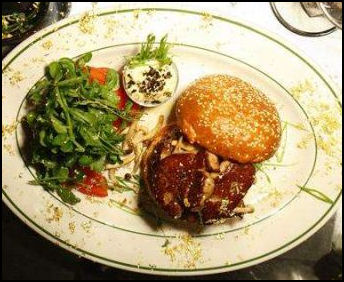
$175 Wall Street Kobe burger Kobe, Matsuzaka, Maeda and Omi beefs are famous for their taste, tenderness, beautifully marbled appearance and high prices. Marbled means that meat has a lot of fat in it, which makes it tender. When cooked the fat liquefies, tenderizing the meat and giving it a mellow, delicate taste.
Meat is given a rank of between one and 12 in Japan. The differences between Kobe, Matsuzaka, Maeda and Omi beef are subtle and difficult for non-Japanese to appreciate. Omi beef comes from Shiga Prefecture. It has a tradition that dates back to 1590. There is a record of beef from there, marinated in soybean paste, being given to the Tokugawa shogunate between 1781 and 1788. Beef from the Iga region is also greatly prized. It comes from the Iga area in Nara, where ninjas are also from and not far from where Matsuzaka beef.
The cows for Japan's top beef come almost exclusively from the Tajima Valley in Hyogo Prefecture. These cows have official papers with their nose print and information on their bloodlines that goes back several generations. The ancestors of these cattle are said to have arrived from Korea in the 5th century B.C. Producers buy the calves when they are about 8 months and slaughter them when they are between 32 and 35 months old.
Only heifers and bullocks (males castrated at three or four months) are sold. Bulls are considered inferior because male hormones are thought to toughen the meat. The best animals are sold at auction on Tajima and Tanba and on Awajishima island, all near Kobe in Hyogo Prefecture.
See Separate Article KOBE BEEF, WAGYU AND EXPENSIVE BEEF IN JAPAN factsanddetails.com
Cloned Beef in Japan
Japan has pursued the cloning of livestock more aggressively than almost any other country. It has the largest cattle-cloning program in the world. Between 1990 and 2000, more than 500 head of cattle were produced through cloning.
In April 2000, it was revealed that beef from 144 of 461 cloned calves sold from livestock experimentation centers.
Later at a meat market, five stores and a restaurant in the Tokyo cloned beef was sold under a banner "Cloned Beef — Experiment Sale." The meat was cheap and consumers lapped it up, with value obviously talking precedent over animal rights and health concerns. .
Foot and Mouth Disease in Japan
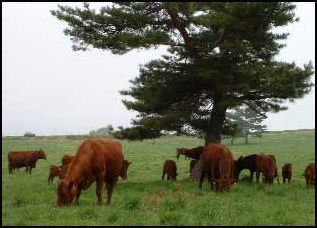
The worst foot and mouth disease outbreak since World War II broke out in the spring of 2010 in Miyazaki, an area in southern Kyushu famous high-quality beef. The disease was discovered in Japan in April 2010 in Tsunocho in the Ebino area of Miyazaki Prefecture. At one stricken farm in the Kawaminamicho adult pigs tried in vain to stand up as dead piglets lay beside them and shaving of pigs hooves were found scattered about the floor. Farmers were hit hard as one might expect. Many lost animals they had poured a lot of money into and had to honor contacts to buy feed even after their animals were dead.
A state of emergency was declared in May 2010. A ban on the transfer of livestock was put in place and an order was given to cull all the pigs and cows within a 10 kilometer radius of the outbreak. Tens of thousands of pigs and cattle were culled. Several hundred farms in Ebino, Tsunocho, Kawaminamicho , Takanabechpo and Shintomucho in the prefecture were affected. Residents in affected areas were told to stay put in their homes and not go out unless it was absolutely necessary. Even animals that had been vaccinated for the disease and prized stud bull worth hundred of thousands of dollars, including one that produced 220,000 top-quality calves, were slaughtered.
Later foot and mouth disease spread to 11 municipalities in Miyazaki Prefecture, one of Japan’s prime livestock-raising areas. It spread in part because of resistance to slaughter pigs and cows and slowness in burying them after the disease was detected and a failure to take more rigorous measures to halt traffic coming out of infected areas. After foot and mouth disease was discovered in June 2010 in the city of Miyakaonojo, Japan’s top beef and pork producing city a state of emergency was declared. Movement of livestock was restricted in areas around the city. Livestock within 10 kilometers of the farm was not allowed to be moved from their barns. Livestock within 20 kilometers of the farm was not allowed to be moved outside the area. New cases of disease appeared in early July.
Foot and mouth disease is a highly contagious disease that affects cloven-hoofed animals such as cattle, pigs and water buffalo. It causes excessive salivating and produces sores in mouth and on the feet — hence the name. Pigs and cattle were killed and buried in mass graves dumped with lime. Some farmers begged to have their valuable stud bulls saved — but they were also killed. In the end 289,000 pigs and cows were slaughtered, 1,250 affected farms had to be fully sanitized and animal excreta and carcases had to be disposed of to ensure the virus was eradicated.
The stare of emergency was lifted after about six weeks after the crisis began and the epidemic was declared over after four months in September. Foot and mouth disease cost Miyazaki Prefecture around $2.5 billion. The outbreak led to closures of public facilities and force the cancellation of nearly 300 sports and other public events. The reputation of Miyazaki food products and its travel industry were damaged. There were reports of trucks from Miyazaki being told to turn back when they showed up in other prefectures because or rumors they carried the disease. Farmers who lost animals were given assistance but many had difficulty resuming their businesses.
It is not clear how foot and mouth disease entered the Miyazaki region. The spread was blamed on “detection delays” and a slow response. It was found that several dozen cases of the disease existed before the disease’s official conformation and farmers from farms with infected animals visited one another after travel restrictions were out in place.
The all clear sign was finally given in November 2010. Questions were raised about how the whole episode was handled? Why were stricter measures not taken when disease was first detected? Why were so many special cases made for specific farms and prized stud bulls? Why were transportation restriction in and out of infected areas not more rigorously enforced? Privacy laws, the need to get the consent of farms without infected animals slowed the process and the precedence of local interests over national ones increased the likelihood of the disease’s spreading.
Mad Cow Disease in Japan
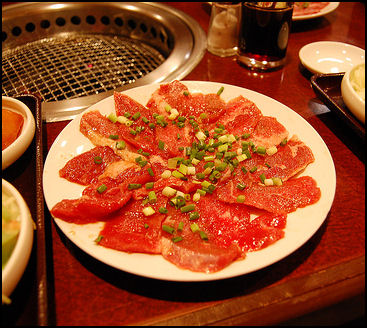
On October 18, 2001, the Japanese government announced that a dairy cow had been discovered with mad cow disease (bovine spongiform encephalopathy, BSE). It was the first time the disease had turned up in Japan. A second case was announced in November 2001. Ultimately four cows were found with the disease after a million cows were tested.
The outbreak of mad cow disease caused beef consumption to decline by 30 percent to 70 percent in the month after the initial outbreak. Foot dragging and indecisiveness by the government didn't help matters.
Because of worries about contamination, slaughter houses refused to take older cattle and because of that some cattle were simply abandoned and picked up wandering on the sides of roads. In the end, The government bought and burned cattle suspected of having contacted the disease. Domestic beef was also incinerated and beef producers were given subsidies. An investigation of subsidized meat found that much of it was foreign, meaning there were some cheaters out there
Three of the four cases of disease were traced to a milk-substitute feed eaten by the four cows when they were calves in 1996. The feed contained animal fat from the Netherlands, where there were 21 cases of mad cow disease in 1997. Instead of banning the suspected feed outright after the mad cow outbreak in 1996, the government only issued guidelines and made them voluntary. Some farmers ignored the guidelines and imported the feed.
As of December 2005, 21 cases of BSE has been reported in Japan.
Ban of American Beef in Japan
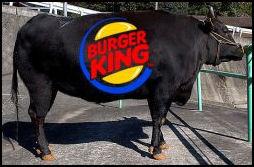
A ban on the import of American beef was imposed in December 2003 after the first case BSE was found in the United States. Japan wanted the United States to check all beef coming into Japan for BSE, an effort that could cost the United States millions a year. Beagles were introduced at Narita airport outside Tokyo to sniff out banned meat products.
The ban caused some hardships. The food chan Yoshinoya was forced to discontinue its popular beef and rice gyudon bowl, which sold for only ¥280 a bowl and was a fixture of salarymen lunches. Beef prices had risen so high that the chain could no longer afford to offer such a cheap dish. Customers and chain employees wept when the last bowls were served up. Yoshinoya was hit hard by the changes. The ¥280 gyudo bowl accounted for 90 percent of chain’s sales and 99 percent of their beef came from the United States.
The United States responded to Japanese ban in American beef by banning Kobe beef. This didn’t cause so much hardship. The United States only imports $800,000 worth of it a year and U.S. rancher now produce their own “Kobe-style” beef with wagyu cows.
Japan lifted the ban on U.S. beef in December 2005 on the condition that meat came from animals 20 months or younger and that risky parts like spinal chords that can spread the disease be removed before shipments. Japan resumed beef imports from the United States in January 2006 only to quickly reintroduce the ban after banned spinal chord parts were found in a shipment from the United States.
The ban was lifted again in July 2006. By that time the damage had been done. In a survey in August 2006, 80 percent of the Japanese interviewed said they were wary about eating American beef.
The gyudon (beef bowl) returned to the menu at Yoshinoya in September 2006 for the first time since February 2004.
As it stands now the imports of cattle over 20 months from the United States is banned. In April 2010, the Obama administration reopened negotiations on American beef with the aim of getting Japan to agree to allow the import of beef from cattle less than 30 months old. The Hatoyama government was not expected to budge much on the issue as it had adopted ensuring food safety as one of its key campaign promises.
Horses in Japan
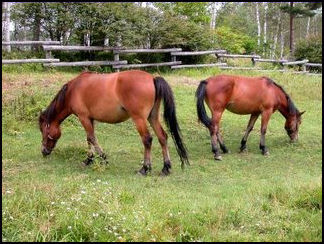
People in Kyushu enjoy eating horse meat and some even eat raw horse meat. Regarded as a delicacy, it is chewy and has a surprisingly sweet flavor. Cuts from the hindquarters are regarded as the best. Most of the horsemeat is imported from United States, South Korea, Chile and Australia. Horse is also widely eaten by people on France and Belgium.
Seven of eight breeds of horse indigenous to Japan have less than 100 horse left. These include the Tokara horse on Tokara Island in Kagoshima Island and the Koiso of Gogfu and Nagano Prefectures. These horses are short in stature, and are believed to have descended from Mongolian horses. Efforts are being to breed them in zoos. The Tokara horse, standing only 120 centimeters at the shoulder, is the shortest Japanese horse breed. It has been bred to be resistant to heat and work in sugarcane fields. Rhe Kiso horses were favored by warriors in the Minamoto clan in the 12th century and once there were tens of thousands of them.
The medium-size Kiso horse is the only horse breed indigenous to Honshu. Named after the Kisogawa River in Nagano Prefecture, it is known for its long body and short, robust legs and amicable temperament. Over the centuries it has been used mainly as a farm animal. The breed nearly went extinct when the government began encouraging owners to crossbred them with other breed to produce stronger war horses in Meiji Period. In 1939, before World War II, a law called for the castration of Kiso and other indigenous horses to Japan. Every Kiso that is alive today can trace its origin back to a single stallion in 1949. Today there are about 150 Kiso horses. Inbreeding is a serious concern because there are so few of the horses. As a result all living Kiso horses have had their DNA analyzed and have been divided into five groups that will breed only with horses outside their group to try and ensure the most genetic diversity possible.
Most Japanese horse saw their numbers sharply decline un the early 20th century a result of crossbreeding with foreign breed to produce strong horses for the military. In 1900 90 percent of the 1.5 million horse in Japan belonged tp indigenous breeds. At the start of the occupation of China in 1931, 90 percent were foreign breeds or crossbreeds.
White Yolk Eggs and Long-Tailed Roosters in Japan
The city of Kochi on the island of Shikoku is famous for long tailed roosters. A rooster with tail 34 feet 9½ inches long was recorded in 1972. Modern long-tailed rooster breeding began in the late 1940s. The secret is finding a rooster that has a calm disposition and can stand be confined in a cage for the 12 or so years, the length of time necessary to grow a really long tail. Rowdy roosters trample all over their tails. [Source: Frank Ogasawara, National Geographic, December 1979]
The long-tailed rooster has been designated a national treasure. The tail feathers of roosters were placed on ceremonial spears by the Yamanouchi family in Kochi in 1603 during the daimyos annual trip to Edo. According to legend the birds developed their long tails through crossbreeding them with pheasant. This seems unlikely and genetic research is being done to determine the bird’s origin.
The roosters are fed twice a day and live to be about 10 years old. Efforts are made to keep them calm so they don’t jump around and damage their feathers. When they are 10 months old they are moved to narrow rearing boxes — long enough to accommodate their tails’so they do not hurt or dirty themselves.
Breeding and rearing the roosters is difficult. Only one in 200 chicks has what it takes and even then may don’t make it do adulthood when they may start developing feathers with undesirable colors. Inbreeding is also a problem.
Silkies, a breed a chicken described by Marco Polo are believed to have originated in China and Japan. They have deep purple skin and plumage that resembles Angora wool.
Before the bird flu was found there about 60 percent of Thailand’s chicken exports went to Japan,
These days more and farmers are using rice as feed for chickens and pigs. One of the affects of this is that rice-fed chickens produce yokes that are nearly white (corn feed is one reason why egg yokes are usually yellow). Pork from rice-fed pigs is said to be quite tasty. Using rice in this way helps rice farmers find markets for their crops and increases Japan’s efforts to be more self-sufficient in food production.
Bird Flu in Japan
Avian cases of bird flu were reported in February, 2004. The first cases were at poultry farms in Yamaguchi and Oita Prefectures with the serious cases in Kyoto and Hyogo prefectures. Hundreds of thousands of birds, mostly chickens, died of the disease. Farms were sealed off. Hundreds of thousands of birds were culled. The military was deployed to sterilize vehicles. Most of the culling was done by government health officials who killed the birds by placing them in bags filled with carbon dioxide. The bags were then buried. It was the first outbreak of bird flu since 1925.
A few restaurants switched to ostrich meat as an alternative to poultry. The owner of poultry company charged with failing to report bird flu cases at a company farm killed himself and his wife. They hung themselves and left behind a note that said they were sorry for “great trouble we’ve caused.”
In December 2004, it was revealed that one Japanese person had bird flu and four others probably had it. Health officials said that maybe hundreds came down with the disease but displayed no symptoms. The disease was picked up in the outbreak in February and March and was detected later using test that measured the production of antibodies to the disease. The people who go bird flu are believed to have picked up the disease from contact with chickens with bird flu. No one died or was even seriously ill.
Mad Cow Disease, BSE, See Livestock.
Bird flu was reported in Okayama and Miyazaki Prefectures in January 2007. A number of chickens died. Tens of thousands were culled, Some 2,400 chickens killed at a poultry farm in Miyazaki Prefecture. Farms within a 10 kilometers radius of the farm with the dead chicken were prohibiting from shipping chickens or eggs.
In April 2008, H5N1 bird flu was detected in three dead or dying swans in Lake Towada in Akita Prefecture in northern Japan and the Notsuke Peninsula in eastern Hokkaido. Another dead swan with H5N1 was found in Hokkaido in August 2008.
Bird Flu in Japan in 2010
People became alarmed at Japanese bird sanctuaries, zoos and poultry farms after several species of migratory birds in different regions were found dead and infected with the highly infectious and lethal H5N1 avian influenza, or bird flu. The problem then spread to poultry farms, requiring the culling of hundreds of thousands of birds to bring the problem under control. Bird-related events, such as Emperor penguin walk at the Osaka Aquarium, and chick-petting at zoos were canceled. At zoos there were worries that endangered species as well as humans might contact the disease.
In December 2010, bird flu was found among dead swans in Toyama Prefecture and Tottori Prefectures and was also detected among dead rare white-naped cranes and hooded cranes in Kagoshima Prefecture. In Toyama Prefecture, a dead mute swan led to inspections of nearby poultry farms and a decision by a park in Hyogo Prefecture, on Japan’s Inland Sea, to stop displaying its white storks, a national treasure, for fear that they would come into contact with infected wild birds.
In Tottori Prefecture, a wild tundra swan was found on a house balcony dying of what was tentatively identified as the bird flu virus. Late the disease was found on a poultry farm about six kilometers away. That set off a search of the area, turning up 23 more dead birds, which were tested for bird flu. A hooded crane was found dead of H5N1 on the Izumi Plain in Kagoshima Prefecture in southern Japan, several hundred miles south of Toyama and Tottori. The plain is Japan’s largest wild crane wintering site, and the prefecture is the nation’s top poultry-raising area.
In November , H5N1 bird flu was found in chickens in Shimane Prefecture and in the feces of wild ducks in Hokkaido. More than 23,000 chickens were killed in Shimane. The chickens were believed to have picked up the flu virus from a small wild bird infected with the disease found at the farm with the infected chickens.
In January 2011, bird flu was found at poultry farms in Miyazaki Prefecture near Kagoshima. More than 410,000 chickens were culled there. One-hundred-seventy soldiers in Japans’s Ground Self-defense Force were dispatched to help bury the birds. In Aichi Prefecture near Nagoya 150,000 chickens were culled after infected chickens were found at a poultry farm there. At around the same time the disease appeared in Izumi, Kagoshima Prefecture near where the infected cranes had been found. That area has 5.22 million chickens in 162 poultry farms. About 8,600 chickens were culled there and the transportation of eggs and chickens within a 10 kilometer radius of the area where infected birds were found was prohibited. In February , 13,000 chickens were culled in Oita Prefecture when brid flu was found there.
See Bird Flu, Health
Image Sources: 1) 8) Japan Animals blog 2) 7) xorsyst blog 3) Aomori Prefecture tourism 4) 5) Hector Garcia 6) Nicolas Delerue
Text Sources: New York Times, Washington Post, Los Angeles Times, Daily Yomiuri, Times of London, Japan National Tourist Organization (JNTO), National Geographic, The New Yorker, Time, Newsweek, Reuters, AP, Lonely Planet Guides, Compton’s Encyclopedia and various books and other publications.
Last updated July 2011
